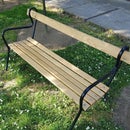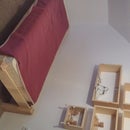Introduction: Toy Chest for Kids
In this instructable I am going to show you how something pretty simple can be mind-blowing for the kids. If you tell the kids that this is their storage box and that they need to keep it clean, they will also search the whole house to find every toy that they have and place it into the Toy Chest. On the upper picture, you can see my daughter wanting to put everything inside :) but she lacks space. So, it is time to write how I managed everything and show how to keep the kids in the loop - they will learn something and respect the tools as well as the work they invest.
Tools that you need are pricey but you can also buy the wood in different sizes and shapes that are already flat on every side, I have the jointer/planer to do it myself and for me the wood in the store is quite pricey. But if I did not have the right tools I probably would go and buy that wood and create something with my kid.
Tools:
-Jointer
-Planer
-Circular saw
-Drill - driver
-Orbital sender
-Router
-Router round bit
-Dowels, doweling jig (optional)
Materials:
-Wood (pine, fir, etc. (If doing it by yourself it is 20$, if buying dry flat wood almost triple the price)
-Dowels (50pcs - 5$)
-Glue 0.5 l (I am using the Kleiberit D303 5$)
-Sanding disk 180/240/320 x3 (6$)
-Sanding paper 80/120/180/240 (6$)
-Disposable gloves
- Polyurethane Layer and finish coat 0.5 l (10$)
Step 1: Prepare Wood and Glued Together
Everything starts with sketches, but right now I did not want to start sketching, because I had scrap pieces laying around in the workshop. I laid the boards on the table just to see how to use them as much possible without creating any unnecessary waste. We need two larger pieces for table top and bottom, two smaller for left, right and also front and back sides, but the last two I left for the end. After 45 minutes of measuring, I calculated that the chest is going to be 40 cm in height, 120 cm long and 40 cm in width.
The wood was cut in the size of 10-13 cm width, and then glued together. For this I used pipe clamps, great stuff for work like this, I only use three of them per board. Also, I put the F clamps on the outer sides to prevent some warping. Good stuff to do is after the glue is squeeze out, clean it with water, it is much easier to remove with water then after it has hardened; after hardening you can get some tear out pieces as a result.
Step 2: Mixing Wood
Scrap wood that lays around on the workshop’s floor and you do not want to throw it away is very common for every woodworker; I am always thinking of how I am going to use that somewhere and that somewhere happens after three years or maybe even more. On the upper picture, you can see the pine in middle part and fir on the outside.
I know for a fact that this pine is probably moving from one corner to another in the workshop for almost two years - finally I found a way to use it - this piece will be the bottom of the toy chest.
Step 3: Getting Some Shape
Everything has hardened and the next step is to cut it to the determined size, bottom and the top part I did not want to cut before the main part box is drilled for dowels and glued. After cutting the orbital sender my first choice is to clean everything, that is the easiest job, and also the most satisfying one right now :)
Step 4: Drilling
When it gets to the drilling and dowels, Wolcraft’s drilling jig is precious to me, in just a few seconds you get to the center and transfer the holes on the other end. The key here is to have a sharp drill bit, if you do not you get blown wood on other side like me; also, do not forget to mark the sides when drilling. A simple fix with blown wood is to put one dowel more in the same hole, then cut it out and mix with fine dust or wood filler, that will be enough to hide the problem.
When tightening with clamps watch out at your diagonals, with half turn on handle you can get box out of square and also measure from one to another corner just to be sure that everything lines up.
Step 5: Chest Top
The first idea was to have the two hinges for top, after that a piano hinge across, then maybe two pneumatic pins, but the kids toy chest needs to be simple, and children cannot get bumped into head while throwing toys in or out. This is what I think is the best - find some scrap pieces and round only one face on the router, the measure for this is 2 x 1 cm 35 cm long.
This needs to be done before the bottom part, so you can have access to the top from the inside. Layout the top and put the box on that, now you just need to position this 2 "wood rods" one on each side and put the glue on that, after 5 min you can remove the box and put some pressure on the "wood rods".
Top part will neatly sit on the box every time, you just need to slide on the box until the top does not drop down. A child can move this without a problem, and does not get bumped into the head. After, remove the top and you can sit and play on that, maybe put some papers on it and draw, possibilities are endless :)
Step 6: Bottom Part
This is a fairly straight forward process, turn the box upside down, and glue the bottom. My mistake here was that I forgot to move the box to the end of the table, so I did not have enough space to put clamps on one side, so I needed to drill and put 4 screws before glue started hardening.
Step 7: Round the Corners
Sanding is done by hand on the edges, first with 120/180/240 sand paper, I think that is more than enough. Bring your kid so that he/she can help you, do not be mad if it does not look great let them have fun, even after a few minutes they will find screws and ask you to drill holes to play with something else - I know mine did.
Step 8: Painting
Painting is always a nice activity, you start seeing the final look of the project, grain starts to pop-up and everything looks the way you want it. Also, if you are painting outside you can give your child a small brush and water, find some scrap wood that you are going to throw away and let the kid "paint". Try talking with your kids while you are doing it, how to hold the brush, how to watch not to spoil anything and similar, I do it all the time. My daughter is only 2.5 years old, and every time dad goes into the workshop she goes with me even it is only for a few minutes.
Step 9: Happy End
Minutes after I brought the toy chest inside, she started collecting boxes, toys, everything that belonged to her, putting it in fast enough that I got blurred images :)
This is a simple Toy Chest - after including the young ones into this they will learn a few things down the road, and so will we.





